Veria 作者: 来源: 发布时间:2021-07-13
I.Population and Area
Location within the region
Coordinates: 40°31′N 22°12′E
Area
• Municipality 796.5 km2 (307.5 sq mi)
• Municipal unit 359.1 km2 (138.6 sq mi)
Elevation 128 m (420 ft)
Population (2011)
• Municipality 66,547
• Municipality density 84/km2 (220/sq mi)
• Municipal unit 48,306
• Municipal unit density 130/km2 (350/sq mi)
Time zone UTC+2 (EET)
• Summer (DST) UTC+3 (EEST)
Postal code 591 31, 591 32
Area code(s) 2331
Vehicle registration ΗΜ
Veria,officially transliterated Veroia, historically also spelled Berea or Berœa, is a city in Central Macedonia, northern Greece, capital of the regional unit of Imathia. It is located 511 kilometres (318 miles) north-northwest of the capital Athens and 73 km (45 mi) west-southwest of Thessaloniki.
Even by the standards of Greece, Veria is an old city; first mentioned in the writings of Thucydides in 432 BC, there is evidence that it was populated as early as 1000 BC. Veria was an important possession for Philip II of Macedon (father of Alexander the Great) and later for the Romans. Apostle Paul famously preached in the city, and its inhabitants were among the first Christians in the Empire. Later, under the Byzantine and Ottoman empires, Veria was a center of Greek culture and learning. Today Veria is a commercial center of Central Macedonia, the capital of the regional unit of Imathia and the seat of a Church of Greece Metropolitan bishop in the Ecumenical Patriarchate, as well as a Latin Catholic titular see.
The extensive archaeological site of Vergina (ancient Aegae, the first capital of Macedon), a UNESCO World Heritage Site containing the tomb of Philip II of Macedon, lies 12 km (7 mi) south-east of the city center of Veria.
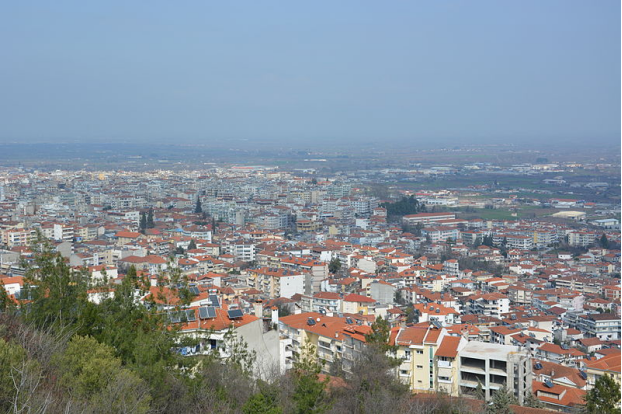
II.Natural Geography (environment and resources)
Geology
Veria is located at 40º31' North, 22º12' East, at the eastern foot of the Vermio Mountains. It lies on a plateau at the western edge of the Central Macedonia plain, north of the Haliacmon River. The town straddles the Tripotamos (river), a Haliacmon tributary that provides hydroelectric power to the national electric power transmission network and irrigation water to agricultural customers of the Veria plain.
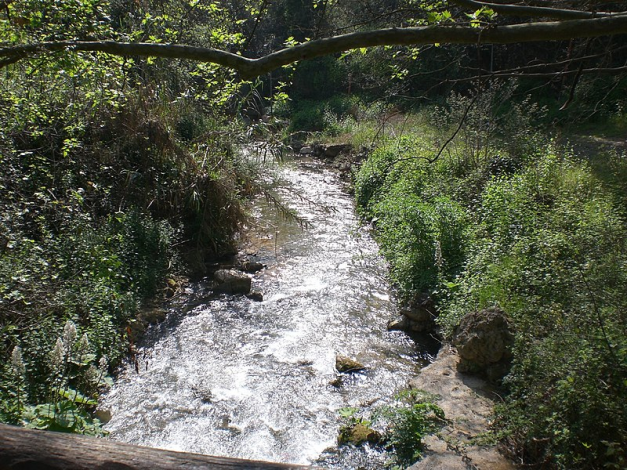
Barbuta river across the city
Climate
Veria has a humid subtropical climate (Köppen climate classification Cfa) that borders on a cold semi-arid climate (Köppen climate classification BSk). Since the city lies in a transitional climatic zone, its climate displays characteristics of continental, semi-arid and subtropical/Mediterranean climates. Summers (from April to October) are hot (often exceptionally hot) and dry (or mildly humid, with rainfalls that occur during thunderstorms), and winters (from mid-October to March) are wet and cool, but temperatures remain above or well above freezing (meteorological phenomenon of Alkyonides). Snow typically falls once or twice a season. Major temperature swings between day and night are seldom.
Infrastructure - transport
Veria is linked to Thessaloniki by the Thessaloniki-Edessa railway, with connections to Athens and Alexandroupoli. Veria is connected to the motorway system of Greece and Europe through Egnatia Odos, the Greek part of the European route E90. It is also connected to more than 500 local and national destinations via the national coach network (KTEL). Thessaloniki International Airport "Macedonia" is the closest international airport, located 88 km (55 mi) east-northeast of Veria.
III.Economy
The modern town has cotton and woolen mills and trades in wheat, fruit and vegetables. Lignite mines operate in the area. The largest wind farm in Greece is to be constructed in the Vermio Mountains by Acciona, S.A.. It will consist of 174 wind turbines, which will be connected to the national electric power transmission network, generating 614 MW.
IV.Industrial Characterisitics
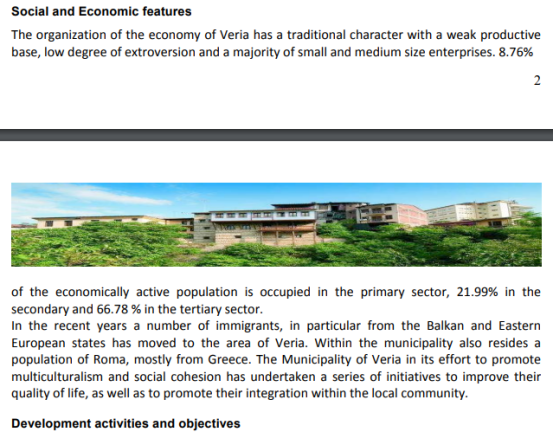
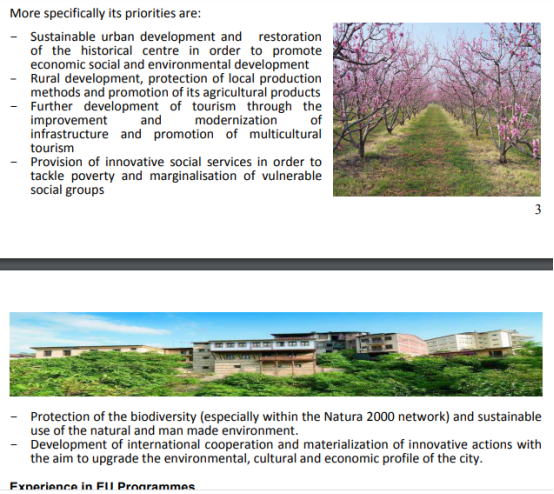
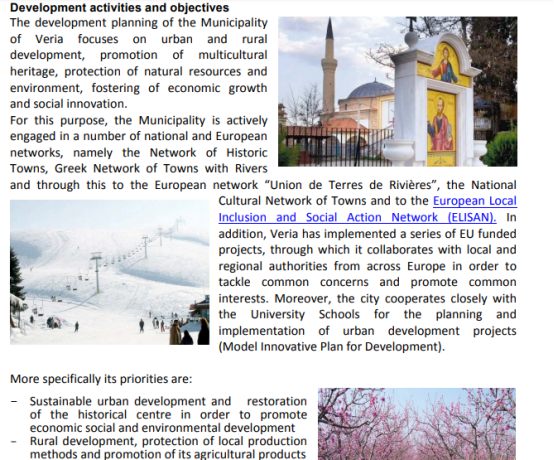
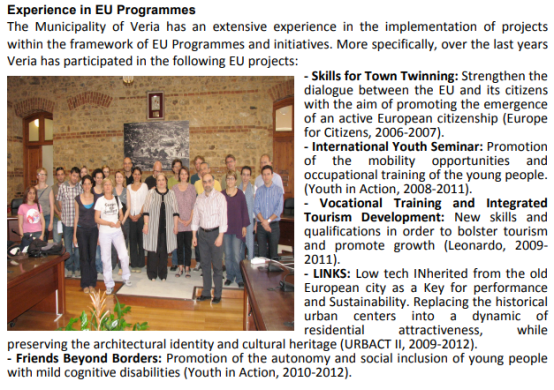
Reference:
https://creativeeurope.in.ua/storage/documents/21112018/MUNICIPALITY_OF_VERIA.pdf
V.Attractions
1, Archaeological Museum of Veria (Beroea)
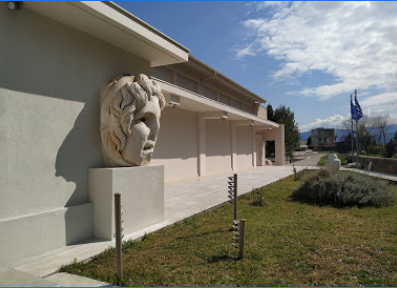
The Archaeological Museum of Veroia is one of the most important archaeological museums in Macedonia, Greece. The museum was established in 1965 in a building constructed especially for the purpose in Elia, one of the loveliest parts of the town. Finds from the Palaeolithic to the Ottoman period are displayed in its three halls.
The Neolithic finds come from the settlement at Nea Nikomideia, which is believed to be the oldest known permanent settlement in Europe. The Iron Age finds come from the cemetery of Vergina.
In the first hall are special showcases displaying a bronze kalpis or cinerary urn of the fourth century BC, a red-figure bell crater of the Kertsch type of the fourth century BC, and a bronze hydria kalpis used as a cinerary urn of the fourth century BC from the north-east cemetery of Veroia, and a reconstruction of a single-chambered rock-cut family tomb of the Hellenistic period, which was excavated in Veroia. Various other showcases display groups of finds from pit graves, cist graves, and rock-cut graves excavated in Veroia’s north-east, south-east, and south-west cemeteries. These groups illustrate the development of pottery and koroplastics from the end of the fifth to the end of the second century BC.
The second hall contains mainly grave stelai and Hellenistic and Roman reliefs of the first century BC from the Veroia area. Of particular note are the stela bearing the Gymnasiarch’s Law, which describes how middle and senior education was conducted in the Veroia Gymnasium, and the hunter-and-boar group, which is part of the sculptural decoration of a third-century BC grave monument from Vergina. The most notable of the stelai are those of Paterinos Antigonou and Adea Kassandrou.
The third hall contains exhibits of the Roman period, most notably an inscribed bust of the river god Olganos of the second century AD, which was found at Kopanos and is in excellent condition. There are also a grave relief of a husband and wife (second century AD), which was found in Veroia, burial offerings from a cist grave of the Roman period (third century AD), and terracotta figurines from an early Roman tomb.
Outside the museum are dozens of sarcophagi, grave stelai, and statues, the most impressive of all being a head of Medusa, a work of the second century BC, which must have been built into the north wall of the city.
Address: Leof. Anixeos 47, Veria 591 31, Greece
Opened: 1965
Phone: +30 2331 024972
2, Byzantine Museum of Veria (Beroea)
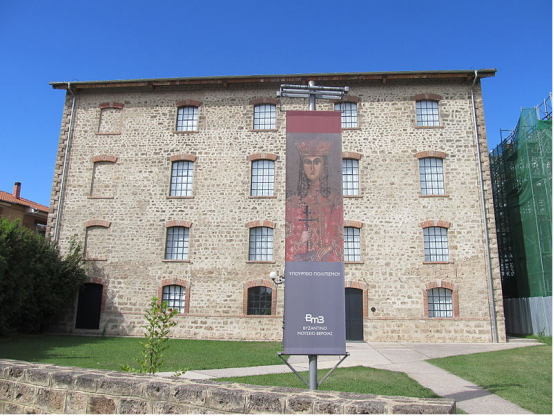
The Byzantine Museum of Veroia was opened in 2002. It is housed in the old Markos mill adjacent to the city walls of Veroia in Central Macedonia, Greece, on the boundary of the listed quarter of Kyriotissa. The museum's founding mission is to make known the monuments in Veroia and the surrounding area, which date from Byzantine and Post-Byzantine times, to make the traditions of the area known and to collaborate with other Byzantine museums in Macedonia to organize periodic exhibitions. The museum's three-storey building will house permanent exhibitions which will retain their artistic self-sufficiency.
The exhibition entitled "Veroia, Part of the Byzantine Empire" is on display on the first floor of the building. It is a particularly fine collection of portable icons (many of which are double-sided), wall-paintings, mosaic floors (from the courtyard of the church of Agios Patapios in Veroia), manuscripts and early printed works, pottery (ceramic items for everyday use and glazed pottery), Byzantine coins and wood-carvings.
Address: Θωμαϊδου 26, Veria 591 32, Greece
Opened: 2002
Phone: +30 2331 025847
3, Altar of Saint Paul
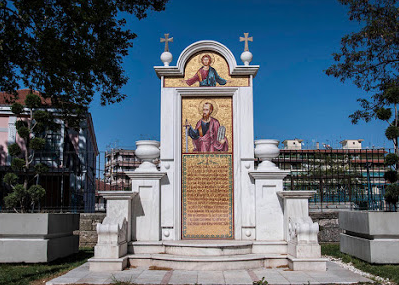
Historical landmark in Veria, Greece
Address: Apostolou Pavlou, Veria 591 32, Greece
Phone: +30 2331 022270
4, Archaeological Site of Saint Patapios
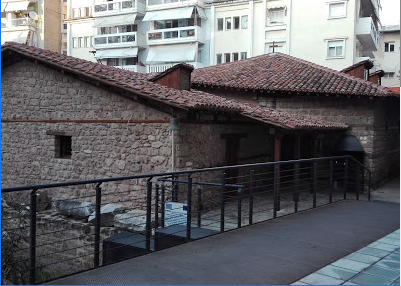
Historical landmark in Veria, Greece
Address: Veria 591 32, Greece
Phone: +30 2331 022787
VI.History
Classical and Roman Veria
Further information: Berea (Bible)
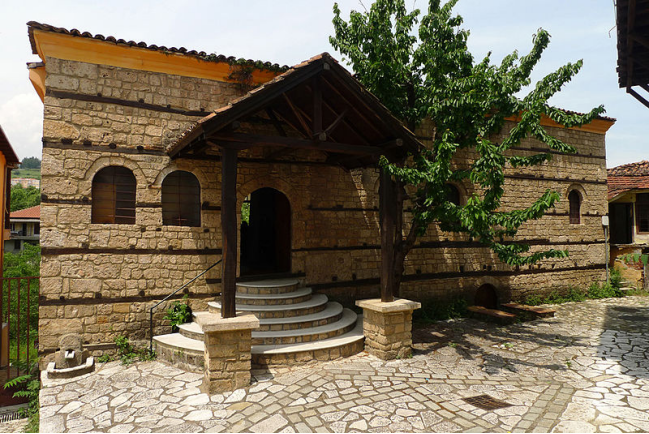
The Jewish synagogue. Veria had a significant Jewish community until World War II
The city is reputed to have been named by its mythical creator Beres (also spelled Pheres) or from the daughter of the king of Berroia who was thought to be the son of Macedon. Veria enjoyed great prosperity under the kings of the Argead Dynasty (whose most famous member was Alexander the Great) who made it their second most important city after Pella; the city reached the height of its glory and influence in the Hellenistic period, during the reign of the Antigonid Dynasty. During this time, Veria became the seat of the Koinon of Macedonians (Κοινόν Μακεδόνων), minted its own coinage and held sports games named Alexandreia, in honor of Alexander the Great, with athletes from all over Greece competing in them.
Veria surrendered to Rome in 168 BC. During the Roman empire, Veria became a place of worship for the Romans. Diocletian made the large and populous city one of two capitals of the Roman province of Macedonia, eponymous in the civil Diocese of Macedonia. Within the city there was a Jewish settlement where the Apostle Paul,[5] after leaving Thessalonica, and his companion Silas preached to the Jewish and Greek communities of the city in AD 50/51 or 54/55. The Bible records:
As soon as it was night, the brothers sent Paul and Silas away to Berea. On arriving there, they went to the Jewish synagogue. Now the Bereans were of more noble character than the Thessalonians, for they received the message with great eagerness and examined the Scriptures every day to see if what Paul said was true. Many of the Jews believed, as did also a number of prominent Greek women and many Greek men. When the Jews in Thessalonica learned that Paul was preaching the word of God at Berea, they went there too, agitating the crowds and stirring them up. The brothers immediately sent Paul to the coast, but Silas and Timothy stayed at Berea. The men who escorted Paul brought him to Athens and then left with instructions for Silas and Timothy to join him as soon as possible.
Ottoman Veria
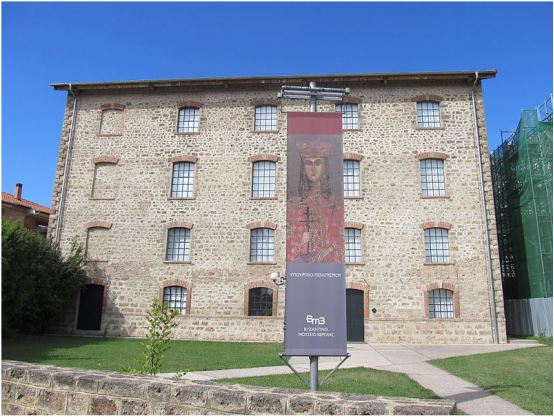
Medrese Mosque
The Ottomans called Veria Karaferye ("black Veria"), because of its characteristic morning mist during the humid winter seasons. Under Ottoman rule, Veria was the seat of a kaza within the Sanjak of Salonica; by 1885, the kaza, along with Naoussa, included 46 villages and chiftliks. The 17th-century traveller Evliya Çelebi reports that the city was peaceful, without walls or garrison; it had 4000 houses, 16 Muslim quarters, 15 Christian quarters, and 2 Jewish congregations. The city was a prosperous center of rice production.
According to the 1881/82-1893 Ottoman General Census, the kaza of Veria (Karaferiye) had a total population of 25.034, consisting of 15.103 Greeks, 7.325 Muslims, 2.174 Bulgarians, 393 Jews, and 39 foreign citizens. Veria was an important regional center of Greek commerce and learning, and counted many important Greek scholars as its natives (e.g. Ioannis Kottounios)
Modern Veria
The presence of a large, prosperous and educated bourgeoisie made Veria one of the centers of Greek nationalism in the region of Macedonia, and the city's inhabitants had an active part in the Greek War of Independence; important military leaders during the uprising included Athanasios Syropoulos, Georgios Syropoulos, Dimitrios Kolemis and Georgios Kolemis, among others; however, as was the case with the rest of Northern Greece, eventually the uprising was defeated, and Veria only became part of modern Greece in 1912 during the Balkan Wars, when it was taken by the Hellenic Army in October 16, 1912 (October 16 is an official holiday in Veria, commemorating the city's incorporation to Greece), and was officially annexed to Greece following the signing of the Treaty of Athens in November 1913.
World War II
During World War II, Veria was under Nazi occupation between 1941 and 1944. An important resistance movement developed in the city, with the left-wing EAM gaining the sympathy of the inhabitants; the people of Veria took part in resistance activities, such as sabotaging the railway, assassinating SS members, and burning Nazi war material. The town asked Prokopis Kambitoglou to become the Mayor of Veria during the occupation. His role in attempting to mitigate the oppression of the Germans was rewarded after the war by the award of the Order of the Phoenix in recognition of his efforts.
During the Occupation almost all of the Jewish community of the city was exterminated by the Nazis.
Postwar
Postwar Veria saw a significant rise in population, and a greatly improved standard of living. The 1980s and 1990s in particular were a period of prosperity, with the agricultural businesses and cooperatives in the fertile plains around Veria successfully exporting their products in Europe, the US and Asia. The discovery of the tomb of Philip II of Macedon in the nearby archaeological site of Vergina (ancient Aegae, the summer capital of the Argead Dynasty of Macedon, now a UNESCO World Heritage Site), also made Veria a tourist destination.
Veria has a significant immigrant population, mainly from countries of Central and Eastern Europe.
Ecclesiastical history
Berrhoea was a suffragan diocese of the Archbishopric of Thessalonica, in the sway of the Patriarchate of Constantinople.
The names of five of its bishops appear in extant contemporary documents:
-- Gerontius took part in the Council of Sardica (c. 344),
-- Lucas in the Robber Council of Ephesus (449),
-- Sebastian in the Council of Chalcedon (451),
-- Timothy in the synod convoked by Patriarch Menas of Constantinople in 536, and
-- Joseph in the Council of Constantinople (869) that condemned Photius.
The Byzantine emperor Michael VIII Palaiologos promoted the local see to an archbishopric after 1261, and it advanced further to the rank of a metropolitan see by 1300.
Latin titular see
The diocese of Berrhoea was nominally restored in 1933 by the Catholic Church as the titular bishopric of Berrhœa (Latin) / Berrea (Curiate Italian).
Its is vacant since decades, having the following incumbents:
-- Cardinal Alfredo Ottaviani (Italian) (1962.04.05 – 1962.04.20)
-- Pierre-Auguste-Marie-Joseph Douillard (1963.05.22 – 1963.08.20) as emeritate
-- Federico Kaiser Depel, M.S.C. (1963.10.29 – death 1993.09.26)
VII.Other information
UNESCO World Heritage Site
Official name Archaeological Site of Aigai (modern name Vergina)
Includes
1, Ancient City and Necropolis of Aegae
2, Bronze Age settlement and Cemetery of Tumuli
Criteria Cultural: (i)(iii)
Reference 780
Inscription 1996 (20th session)
Area 1,420.81 ha (3,510.9 acres)
Buffer zone 4,811.73 ha (11,890.0 acres)
Culture
The city has a number of Byzantine monuments, as well as post-Byzantine churches built on Byzantine foundations. The most significant Byzantine monument is the Anastasis Church (Church of the Resurrection) with its "spectacular frescoes" from 1315, bearing comparison with some of the finest works of Palaiologan art in the main Byzantine centres of Thessaloniki and Constantinople. Of the city's thirteen mosques, eight survive, including the Old Metropolis, which had been converted into the Hünkar Mosque, as well as the Orta Mosque, Mendrese Mosque, and the Mahmud Çelebi Mosque. Four other mosques, the Subashi, Bayir, Yola Geldi, and Barbuta mosques, are now used as private residences. The Twin Hamam also survives, as well as a number of Ottoman public buildings of the late 19th century. The city's famous bezesten, however, burned down in the great fire of 1864.
Museums in Veria include the Archaeological Museum of Veroia, the Byzantine Museum of Veroia, the Folklore Museum of Veroia, a museum of modern Greek history and a laographical museum. There is also a 19th-century Jewish synagogue in the protected Jewish neighbourhood.
The archaeological site of Aegae/Aigai (Αἰγαί; modern name Vergina), a UNESCO World Heritage Site, lies 12 km (7 mi) south-east of the city centre of Veria.
Every summer (August 15 to September 15) the "Imathiotika" festivities take place with a cultural program deriving mainly from Veria's tradition. The site of Elia has an extensive view of the Imathia plain. Neighboring Seli is a well-known ski resort and a few kilometers outside the city is the Aliakmonas river dam.
Education
Veria has one of the largest public libraries in Greece. Originally a small single-room library with limited funds and material, it expanded into a four-story building offering multimedia, and special and rare editions. Veria's public library collaborates with many international organizations and hosts several cultural events. In 2010, it won the Access to Learning Award (ATLA) prize nominated by the Bill & Melinda Gates Foundation and the amount of $1.000.000. Since then, the library became a role model for other libraries in Greece.
The Department of Spatial Planning and Development Engineering of Aristotle University of Thessaloniki was located in Veria since 2004, but in 2013 it was relocated to Thessaloniki.
VIII.Contact information
Mayor: Konstantinos Voriazidis
Tel.: 23313 50505
Address: 46, Mitropoleos Street 59100 VERIA , IMATHIA , GREECE
Tel.: +30 23313 50500 , Fax: +30 23313 59500
